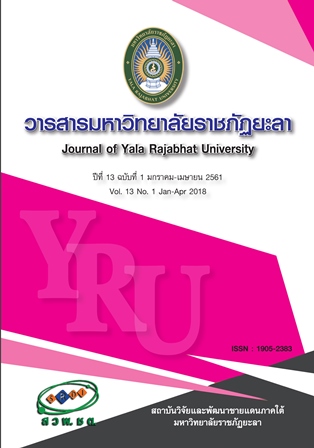เทคโนโลยีสารสนเทศเพื่อการเรียนรู้ทางอิเล็กทรอนิกส์ร่วมกัน : การวัดและประเมินผลการเรียนรู้ตามกรอบมาตรฐานคุณวุฒิระดับอุดมศึกษาแห่งชาติ
Main Article Content
บทคัดย่อ
การเรียนรู้อิเล็กทรอนิกส์ร่วมกันเป็นหนึ่งในวิธีการเรียนรู้สมัยใหม่ที่มีการใช้งานกันอย่างแพร่หลายในศตวรรษที่ 21 ผู้เรียนสามารถเรียนรู้ยามเมื่อต้องการอย่างอิสระและนอกห้องเรียนปกติ โดยปราศจากข้อจำกัดด้านเวลาและสถานที่ งานวิจัยนี้เน้นการประยุกต์ใช้เทคโนโลยีสารสนเทศเพื่อการสนับสนุนการเรียนรู้ของผู้เรียน ผู้เรียนสามารถเรียนรู้และพัฒนาองค์ความรู้ใหม่ร่วมกัน เป็นการเรียนรู้ตลอดชีพ เพื่อเข้าถึงการเรียนรู้ร่วมกันทางอิเล็กทรอนิกส์อย่างมีคุณภาพ ประสิทธิภาพ และประสิทธิผล การเรียนรู้แบบเน้นผลลัพธ์การเรียนรู้เป็นสิ่งจำเป็น งานวิจัยนี้เน้นผลลัพธ์การเรียนรู้ในระดับปริญญาตรีตามกรอบมาตรฐานคุณวุฒิระดับอุดมศึกษาแห่งชาติ ด้วยการพัฒนาระบบการเรียนรู้ร่วมกันทางอิเล็กทรอนิกส์โดยใช้กรณีศึกษาของรายวิชาเทคโนโลยีสารสนเทศเพื่อชีวิต หมวดวิชาศึกษาทั่วไปของมหาวิทยาลัยราชภัฏเพชรบูรณ์ การเรียนรู้ร่วมกันทางอิเล็กทรอนิกส์สามารถสนับสนุนผลการเรียนรู้เฉพาะด้านและผลการเรียนรู้ทั่วไปตามกรอบมาตรฐาน คุณวุฒิระดับอุดมศึกษาแห่งชาติ การวัดและประเมินผลการเรียนรู้เป็นการรวบรวมผลลัพธ์จากการมีส่วนร่วมทางอิเล็กทรอนิกส์ การสอบทางอิเล็กทรอนิกส์ และการมอบหมายงานทางอิเล็กทรอนิกส์ วิธีการทางคณิตศาสตร์ใช้ในการวิเคราะห์ข้อมูล ผลจากการวิจัยพบว่า ผลลัพธ์การเรียนรู้ของผู้เรียนแต่ละรายเป็นไปตามกรอบมาตรฐานคุณวุฒิระดับอุดมศึกษาแห่งชาติ สามารถเปรียบเทียบกับค่าเฉลี่ยของห้องเรียนและแสดงผลในรูปแบบของแผนภูมิเรดาร์ ที่ผู้เรียนสามารถใช้เป็นข้อมูลในการพัฒนาปรับปรุงผลการเรียนรู้ของตนในอนาคต
Article Details
บทความ ข้อมูล เนื้อหา รูปภาพ ฯลฯ ที่ได้รับการเผยแพร่ในวารสารมหาวิทยาลัยราชภัฏยะลานี้ ถือเป็นลิขสิทธิ์ของวารสารมหาวิทยาลัยราชภัฏยะลา หากบุคคลหรือหน่วยงานใดต้องการนำทั้งหมดหรือส่วนหนึ่งส่วนใดไปเผยแพร่ต่อหรือกระทำการใดๆ จะต้องได้รับอนุญาตเป็นลายลักษณ์อักษรจากวารสารมหาวิทยาลัยราชภัฏยะลาก่อนเท่านั้น
References
and Purchase Intentions: Evidence from Chinese Online Visitors. International Journal of
Hospitality Management, Elsevier, 391-402.
2.Baykul, Y., Gursel, M., Salak, H., Ertekin, E., Yazici, E., Dulger, O., et al. (2010). A Validity and
Reliability Study of Grasha-Riechmann Student Learning Style Scale. International Journal
of Social, Behavioral, Education, Business and Industrial Engineering, 4(3), 323-330.
3.Blair, N. (2012). Technology Integration for New 21St Century Learner: Today’s Students Need
Educators to Re-envision the Role of Technology in the Classroom [Online]. Retrieved
February 25, 2016, from: https://www.naesp.org/sites/default/files/Blair_JF12.pdf.
4.Chaibuth, D., Thongboonnak, K., Sankas, S. & Tantranont, N. (2015). The Success Factors for
Using Information Technology for Collaborative Learning Development via Online Social
Network (in Thai). Research and Development Journal, Walaialongkorn, Science and
Technology, 10(2), 1-11.
5.Davis, F. D. (1985). A Technology Acceptance Model for Empirically Testing New End-user
Information Systems: Theory and Results. Ph.D. dissertation, MIT Sloan School of
Management [Online]. Retrieved February 14, 2015, from: https://dspace.mit.edu/
handle/1721.1/15192.
6.DeLone, W. H. & McLean, E. R. (2003). The DeLone and McLean Model of Information Systems
Success: A Ten Year Update. Journal of Management Information Systems, 9(4), 9-30.
7.Funilkun, S. (2008). e-Democracy System Development Framework and Its Quality. Ph.D. Thesis.
School of Information Technology, King Mongkut’s University of Technology Thonburi.
8.Hatthasak, M. (2014). Building the Understanding and Knowledge of Learning Process. Kasetsart
University, Faculty of Education [Online]. Retrieved February 24, 2015, from: regis.rmutp.
ac.th/km_regis/stock/2557/2-57.ppt. (in Thai)
9.Johnson, D. W. & Johnson, R. T. (2001). Learning Together and Alone: An Overview. Asia Pacific
Journal of Education, 2(1), 95-105.
10.Khuprasit, A. (2013). Personality Assessment Form [Online]. Retrieved October 17, 2015, from:
http://www.tistr.or.th/tistrblog/?tag=16-personality-factor. (in Thai)
11.Raksri, P. (2010). Social Network [Online]. Retrieved September 24, 2015, in Engineers Council,
from: http://www.coe.or.th/e_engineers/knc_detail.php?id=170. (in Thai)
12.Schroer, W. J. (2014). Generations X, Y, Z and the Others - Cont’d [Online]. Retrieved November
18, 2015, from: http://www.socialmarketing.org/newsletter/features/generation3.htm.
13.Soller, A. L. (2001). Supporting Social Interaction in an Intelligent Collaborative Learning System.
International Journal of Artificial Intelligence in Education [Online]. Retrieved February
25, 2016, From: http://iaied.org/pub/980/file/980_paper.pdf.
14.Sripan, P. (2012). The Relationship between Five Personality Components and the Effectiveness
of Working: A Case Study of Staffs at the Tisco Bank- Control and Loan Section. MBA
in Management. Srinakharinwirot University.
15.Suktorn, W., Yaowapanee, W., Sirichirakan, W.J. & Lungpadit, P. (2013). The Development of
Learning System According to Information Technology Quality. Journal of Yala Rajabhat
University, 8(1), 52-63. (in Thai)
16.The Office of Higher Education Commission (OHEC). (2008). Higher Education Standard and
Related Standard Regulations. Bangkok: Parbpim Partnership. (in Thai)
17.ThongThai, W. (2013). The Learning Evaluation [Online]. Retrieved August 18, 2015, from: http://
www.bpcd.net/new_subject/library/research/document/sopida/research/ku/develop/08.
pdf. (in Thai)

